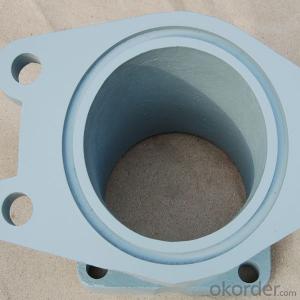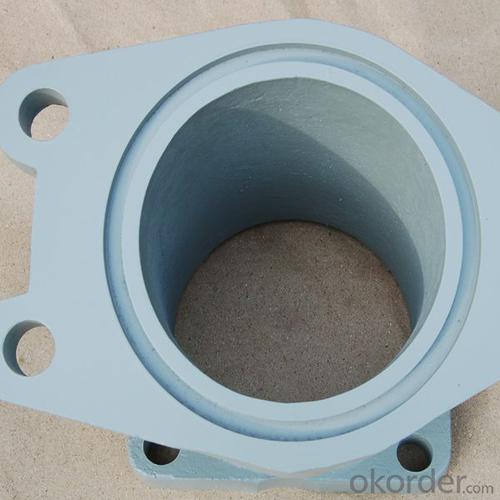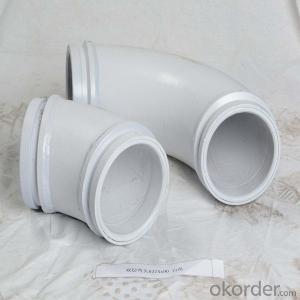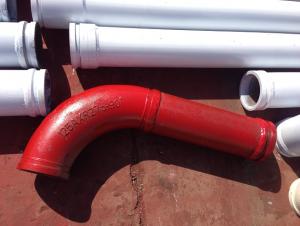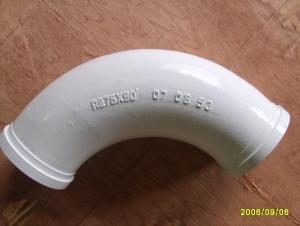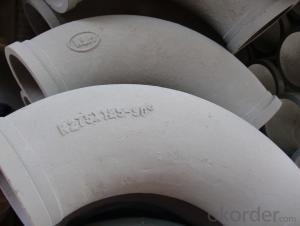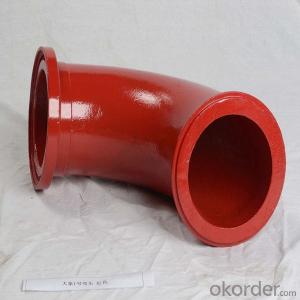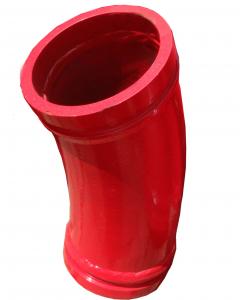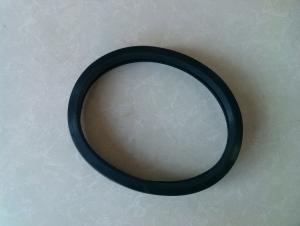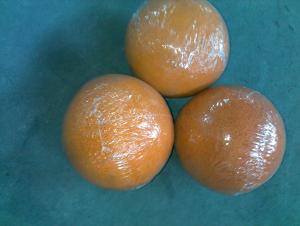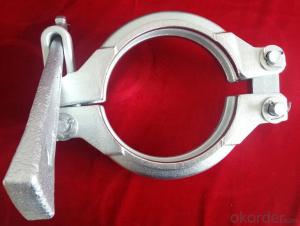Concrete Pumps Spare Parts SCHWING Square Flange Elbow
- Loading Port:
- Tianjin
- Payment Terms:
- TT OR LC
- Min Order Qty:
- 10 pc
- Supply Capability:
- 100000 pc/month
OKorder Service Pledge
OKorder Financial Service
You Might Also Like
Product Description:
The Concrete Pumps Spare Parts SCHWING Square Flange Elbow normally made by special MN13-4, to make sure the quanlity of elbows according to customer’s requests we usually keep the content of MN strictly over 15%, it will have a longer life as well, package will be in plywood box or cartons and put into container. 60 pcs elbows be puted into one plywood box.
Scope of Application of the Goods
The Concrete Pumps Spare Parts SCHWING Square Flange Elbow is a concrete pumps parts for combined use with other concrete parts in for concrete pumps and truck pumps. It can be widely used in the construction of various types of concrete structures like industrial and civil buildings, bridges, roads, and other types of infrastructure.
This seals can be used only on truck pumps, but not in any other operations.
Product Advantages:
OKorder's Concrete Pumps Spare Parts SCHWING Square Flange Elbow Channels are durable, strong, and safety.
Main Product Features:
· Premium quality
· Prompt delivery & seaworthy packing (5-10 days)
Reliable performance
Easy to weld
High safety.
· Professional Service
· Competitive pricing
Measuring of wall thickness from the outside
Low purchase cost
Specifications:
SCHWING Square Flange Elbow 14DEG,Casting
Capacity Life: 30,000 cbm
FAQ:
Q1: How long about delivery time Concrete Pumps Spare Parts SCHWING Square Flange Elbow?
A1: Normally we keep the raw materials for old customers and sometime we also keep stock products to make sure delivery time in any emergency cases.
Q2: How do we guarantee the quality of our Concrete Pumps Spare Parts SCHWING Square Flange Elbow?
A2: We have established an advanced quality management system which conducts strict quality tests at every step, from raw materials to the final product. At the same time, we provide extensive follow-up service assurances as required.
Q3: How soon can we receive the product after purchase?
A3: Within three days of placing an order, we will book the vessel for goods. The specific shipping date is dependent upon international and government factors, but is typically 7 to 30 workdays.
Q4: If we can produce some goods according to customers request?
A4: Yes, we can produce SCHWING Square Flange Elbow according to the difference country situations to make it suitable to the market and customers. We have very professional technical team to make the design for porduction of seals.
Q5: How to make a quick resolution for after service?
A5: OKorder and our manufacture both have overseas branches all-around of world.
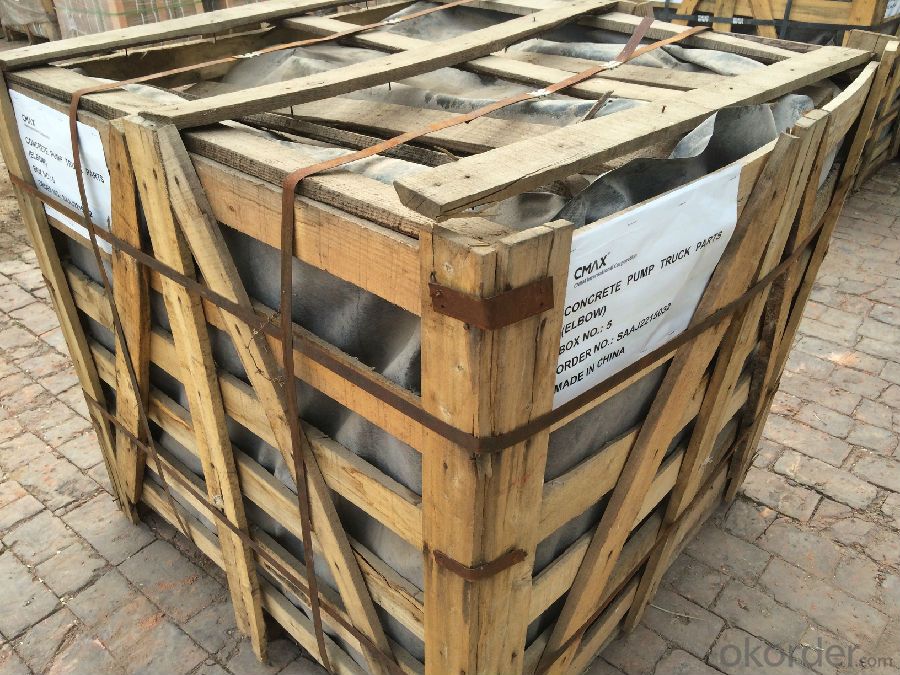
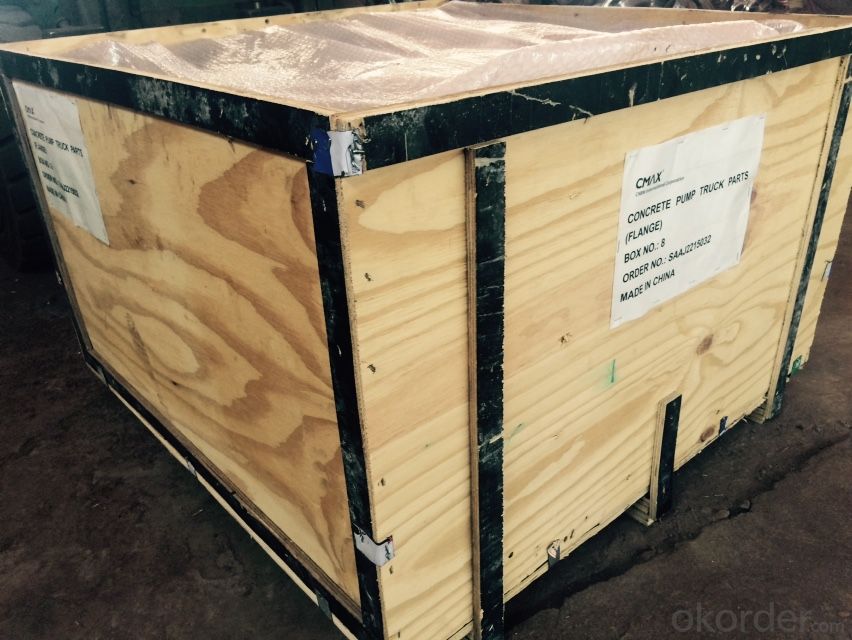
- Q: Are there any specific maintenance requirements for concrete pump spare parts?
- Concrete pump spare parts have specific maintenance requirements that must be met to ensure optimal performance and prolong their lifespan. To achieve this, regular inspection and maintenance are necessary. Here are some key maintenance requirements for concrete pump spare parts: 1. Cleaning: It is important to regularly clean concrete pump spare parts such as pipes, hoses, and valves to remove any accumulated debris, hardened concrete, or contaminants. This can be accomplished by using appropriate cleaning agents and tools. 2. Lubrication: To minimize friction and wear, it is crucial to properly lubricate moving parts like pistons, cylinders, and bearings. It is recommended to use lubricants specifically designed for concrete pump spare parts, following the manufacturer's guidelines. 3. Inspection: Conduct regular inspections of all spare parts to identify signs of wear, damage, or misalignment. This includes checking for cracks, leaks, loose connections, or excessive wear in seals, O-rings, and gaskets. 4. Replacement: Promptly replace any damaged or worn-out spare parts to prevent further damage or potential breakdown of the concrete pump. It is essential to use genuine spare parts recommended by the manufacturer to ensure compatibility and performance. 5. Storage: When not in use, store concrete pump spare parts in a clean and dry environment to prevent corrosion or damage. Utilize proper storage racks or containers to keep the parts organized and protected. 6. Training: Adequately train operators and maintenance personnel on the correct handling, maintenance, and replacement procedures for concrete pump spare parts. This ensures that maintenance tasks are carried out correctly and efficiently. By adhering to these maintenance requirements, concrete pump spare parts can be maintained in excellent working condition, guaranteeing reliable and efficient operation of the concrete pump system. Regular maintenance not only helps prevent unexpected breakdowns but also enhances the overall performance and longevity of the spare parts.
- Q: Can a concrete pump wear plate be repaired or does it need to be replaced entirely?
- A concrete pump wear plate can be repaired in some cases, but it depends on the extent of the damage. If the wear plate has minor cracks or small areas of wear, it can often be repaired by welding or patching. However, if the damage is extensive or if the wear plate is severely worn out, it may need to be replaced entirely to ensure the optimal performance and safety of the concrete pump.
- Q: How often should control system sensors be calibrated or replaced?
- The frequency at which control system sensors should be calibrated or replaced depends on several factors. These factors include the type of sensor, its application, environmental conditions, and the manufacturer's recommendations. In general, it is recommended to calibrate control system sensors at least once a year. However, certain sensors may require more frequent calibration due to their sensitivity or criticality in the system. For example, sensors used in safety-critical applications or those that are exposed to harsh environmental conditions may need to be calibrated more frequently, such as every six months or even quarterly. Additionally, it is important to monitor the performance of control system sensors regularly to ensure accurate readings and reliable operation. This can be achieved through routine maintenance and periodic checks. If any signs of sensor drift, inconsistency, or failure are observed during these checks, immediate calibration or replacement may be necessary. Moreover, the manufacturer's recommendations play a significant role in determining the calibration or replacement intervals. Each sensor has its own specifications and guidelines provided by the manufacturer. It is essential to follow these recommendations to maintain optimal performance and extend the lifespan of the sensor. Ultimately, the calibration or replacement frequency of control system sensors should be determined by a combination of factors including industry standards, application requirements, environmental conditions, and manufacturer's guidelines. Regular monitoring, routine maintenance, and adherence to these factors will ensure that control system sensors operate accurately and reliably.
- Q: How often should hopper agitator motors be inspected or replaced in a concrete pump?
- The inspection or replacement frequency of hopper agitator motors in a concrete pump relies on several factors, including usage intensity, operating conditions, and maintenance practices. However, as a general rule, it is advised to conduct regular inspections of hopper agitator motors every three to six months. Regular inspections can help identify any indications of wear and tear, damage, or malfunction in the motor. These issues may manifest as abnormal noise, excessive vibrations, overheating, or reduced performance. It is also important to check for loose or worn components like belts, pulleys, or bearings, as these can impact the motor's efficiency and lifespan. If any significant issues or malfunctions are discovered during the inspection, it may be necessary to replace the hopper agitator motor. The decision to replace the motor should be based on the severity of the problem, the motor's age, and the cost-effectiveness of repairs versus replacement. In addition to regular inspections, it is crucial to adhere to the manufacturer's recommendations for maintenance and lubrication of the hopper agitator motor. Proper maintenance practices can prolong the motor's lifespan and reduce the need for replacement. Ultimately, the specific frequency of inspections and replacement of hopper agitator motors in a concrete pump should be determined by considering the specific circumstances and conditions of the pump's operation, taking into account the manufacturer's guidelines and recommendations.
- Q: What are the indications of a faulty concrete pump hydraulic motor?
- There are several indications that can point to a faulty concrete pump hydraulic motor. Some common signs to look out for include: 1. Loss of power: If the hydraulic motor is not functioning properly, you may notice a significant loss of power in the concrete pump. The motor may struggle to generate enough force to pump the concrete effectively, resulting in slower or weaker output. 2. Excessive noise or vibrations: A faulty hydraulic motor may produce unusual noises or vibrations during operation. This could be a result of damaged internal components or misalignment, indicating a problem with the motor. 3. Fluid leaks: Hydraulic motors rely on the proper flow and pressure of hydraulic fluid to function correctly. If you notice any fluid leaks around the hydraulic motor or its associated components, it could be a sign of a faulty motor that needs attention. 4. Overheating: When a hydraulic motor is faulty, it may overheat due to increased friction or internal malfunctions. If you notice excessive heat coming from the motor or associated components, it is essential to address the issue promptly to avoid further damage. 5. Inconsistent or jerky movement: A faulty hydraulic motor may cause the concrete pump to operate inconsistently or jerkily. This can result in uneven pouring or difficulty in controlling the flow of concrete, indicating a problem with the motor's performance. 6. Increased energy consumption: If the hydraulic motor is faulty, it may require more energy to operate properly. This can lead to a noticeable increase in energy consumption, which can be observed through higher electricity bills or a greater strain on other parts of the pump's system. It is important to note that these indications may vary depending on the specific make and model of the concrete pump hydraulic motor. It is always recommended to consult the manufacturer's guidelines or seek professional assistance to diagnose and address any issues with the hydraulic motor effectively.
- Q: Can concrete pump spare parts be purchased online?
- Yes, concrete pump spare parts can be purchased online. There are numerous websites and online marketplaces that offer a wide range of concrete pump spare parts for purchase, making it convenient for customers to find and order the specific parts they need for their equipment.
- Q: How often should hydraulic cylinders be inspected or replaced in a concrete pump?
- It is advisable to conduct regular inspections on hydraulic cylinders in a concrete pump, ideally every 500 hours of operation or at least once a year, whichever occurs first. However, it is important to acknowledge that the frequency of inspections may differ based on the specific conditions and usage of the concrete pump. During these inspections, qualified technicians should thoroughly assess the hydraulic cylinders for any indications of wear, damage, or leaks. Additionally, they should verify the alignment, piston rods, seals, and other components to ensure proper functionality. If any issues are discovered, such as excessive wear or leaks, it is recommended to promptly replace the hydraulic cylinders to prevent further damage and maintain optimal performance. The regular inspections and timely replacements of hydraulic cylinders are vital for guaranteeing the safety, efficiency, and longevity of a concrete pump. Neglecting proper maintenance can result in expensive repairs, decreased productivity, and even accidents. Therefore, it is crucial to adhere to the manufacturer's guidelines and seek advice from professionals to determine the appropriate intervals for inspecting and replacing hydraulic cylinders in a concrete pump.
- Q: What is the function of a concrete pump hydraulic motor?
- The concrete pump hydraulic motor serves the purpose of supplying the essential power and force needed for the operation of the concrete pump. Its responsibility lies in transforming hydraulic energy into mechanical energy, thereby enabling the pump to function with efficiency and effectiveness. By propelling the pumping mechanism, it allows the concrete to be transported through the pipeline and delivered to the desired destination. Additionally, the hydraulic motor governs the pump's speed and direction, facilitating accurate placement of the concrete. In conclusion, the concrete pump hydraulic motor plays a vital role in guaranteeing the seamless operation and triumphant delivery of concrete in construction endeavors.
- Q: How to judge the concrete pipeline blockage?
- Listen to the ear, there is rustling sound as normal, there is a piercing sound for the blockage
- Q: Can concrete pump spare parts be coated with corrosion inhibitors for long-term storage?
- Yes, concrete pump spare parts can be coated with corrosion inhibitors for long-term storage. Coating the parts with corrosion inhibitors helps protect them from rust and other forms of corrosion, ensuring their longevity and effectiveness when they are eventually used.
Send your message to us
Concrete Pumps Spare Parts SCHWING Square Flange Elbow
- Loading Port:
- Tianjin
- Payment Terms:
- TT OR LC
- Min Order Qty:
- 10 pc
- Supply Capability:
- 100000 pc/month
OKorder Service Pledge
OKorder Financial Service
Similar products
Hot products
Hot Searches
Related keywords
